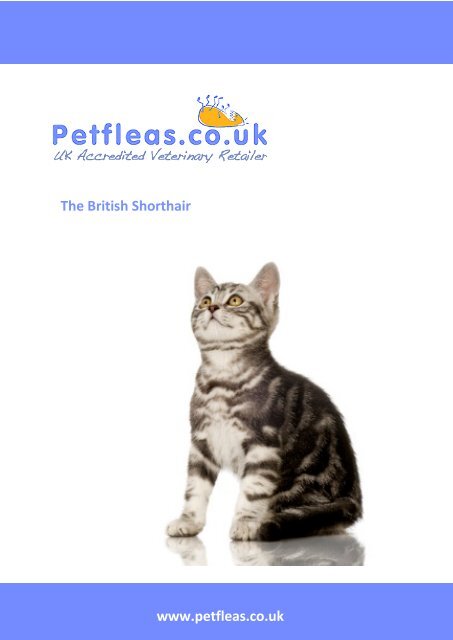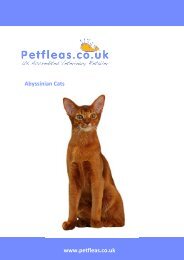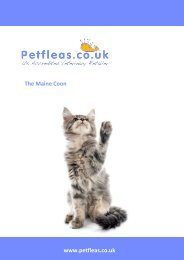Cat Breeds: The British Shorthair
According to the Governing Council of the Cat Fancy (GCCF), an organisation that registers pedigree cats in the United Kingdom, the British Shorthair is the most popular pedigree breed of cat in the country. But to what can we attribute this popularity? In this article, we’ll take a closer look at this well-loved mainstay of British cats. Visit http://www.petfleas.co.uk/
According to the Governing Council of the Cat Fancy (GCCF), an organisation that registers pedigree cats in the United Kingdom, the British Shorthair is the most popular pedigree breed of cat in the country. But to what can we attribute this popularity? In this article, we’ll take a closer look at this well-loved mainstay of British cats. Visit http://www.petfleas.co.uk/
You also want an ePaper? Increase the reach of your titles
YUMPU automatically turns print PDFs into web optimized ePapers that Google loves.
<strong>The</strong> <strong>British</strong> <strong>Shorthair</strong><br />
www.petfleas.co.uk
According to the Governing Council of the<br />
<strong>Cat</strong> Fancy (GCCF), an organisation that<br />
registers pedigree cats in the United<br />
Kingdom, the <strong>British</strong> <strong>Shorthair</strong> is the most<br />
popular pedigree breed of cat in the<br />
country. But to what can we attribute this<br />
popularity? In this article, we’ll take a<br />
closer look at this well-loved mainstay of<br />
<strong>British</strong> cats.<br />
Profile: what is a <strong>British</strong> <strong>Shorthair</strong>?<br />
<strong>The</strong> breed is, perhaps unsurprisingly,<br />
distinctive for its coat of short fur, but it is<br />
also recognisably by its ‘chunky’<br />
proportions: it has well-muscled shoulders<br />
and chests and relatively short legs and a<br />
stubby neck supporting a bulbous head.<br />
Its eyes are big, round and spaced far<br />
apart. <strong>The</strong> breed is also notable for being<br />
sexually dimorphic – which basically<br />
means that males and females are easily<br />
distinguished from one another. <strong>The</strong><br />
former is far heavier than the latter, and<br />
comes equipped with especially<br />
prominent jowls.<br />
History: Where did the <strong>British</strong><br />
<strong>Shorthair</strong> come from?<br />
<strong>The</strong> <strong>British</strong> <strong>Shorthair</strong> is among the oldest<br />
pedigree breeds of cat – its ancestry<br />
stretches back to Ancient Egypt, where<br />
cats were considered to be divine. <strong>The</strong><br />
breed was then brought the Britain by the<br />
Roman invaders of the first century and<br />
interbred with the native <strong>British</strong> wildcats.<br />
In this early period, the breed was still<br />
much the same as it is today – robustly<br />
built, with a short, thick coat to help it<br />
survive the <strong>British</strong> weather.<br />
<strong>The</strong> Victorian era saw cat-breeding<br />
become a serious enterprise, as the upper<br />
classes began to demand increasingly<br />
high-quality breeds. When the <strong>British</strong><br />
<strong>Shorthair</strong> as we know it today made its<br />
debut in 1871, at a cat show in Crystal<br />
Palace, it proved an enormous success.<br />
Harrison Weir, the breeder credited with<br />
first developing the <strong>British</strong> <strong>Shorthair</strong>,<br />
became a rich man almost overnight.<br />
This initial success was to prove shortlived,<br />
however. By the end of Victoria’s<br />
reign, the Persian cat had become the<br />
must-have item among Victorian<br />
aristocrats, and the <strong>Shorthair</strong> began to<br />
wane in popularity. <strong>Shorthair</strong> breeders<br />
attempted to fight this trend by breeding<br />
the <strong>British</strong> <strong>Shorthair</strong> with the Persian in<br />
order to create the <strong>British</strong> Longhair.<br />
Similar crises came later, after the end of<br />
the First World War, when the GCCF<br />
elected to tighten their standards for what<br />
is considered a <strong>British</strong> <strong>Shorthair</strong>.<br />
This decision created yet another shortage<br />
in breeding stock. Breeders decided that<br />
to get around this they would crossbreed<br />
the shorthair with the superficially-similar<br />
French Charteux. It wasn’t until after the<br />
Second World War that <strong>British</strong> <strong>Shorthair</strong><br />
breeders would concentrate once again<br />
on establishing the <strong>British</strong> <strong>Shorthair</strong> as a<br />
breed of its own. <strong>The</strong>se efforts would<br />
yield formal recognition in the 1970s,<br />
when the breed was recognised by cat<br />
fancier organisations on either side of the<br />
Atlantic.<br />
www.petfleas.co.uk
Personality: What is a <strong>British</strong><br />
<strong>Shorthair</strong> like to own?<br />
<strong>The</strong> reason for this particular breed’s<br />
popularity is clear when you first<br />
encounter one – it’s cuddly, friendly and<br />
generally pleasant to be around. <strong>The</strong>y have<br />
no problem being picked up and fussed,<br />
and have the same proportions as a teddy<br />
bear. <strong>The</strong> breed is also remarkably relaxed,<br />
and will happily adapt to all but the most<br />
severe of domestic conditions. If you’re<br />
looking for a cat that’s easy to please, and<br />
that will happily curl up on the sofa, then<br />
the <strong>British</strong> <strong>Shorthair</strong> is for you.<br />
<strong>Shorthair</strong> kittens will be especially bulky in<br />
their proportions, but as they grow older<br />
this feature will slowly diminish and they’ll<br />
become more markedly cat-like. That said,<br />
<strong>British</strong> <strong>Shorthair</strong> kittens tend to be a little<br />
slow to reach full maturity: but give them a<br />
little time and they’ll develop into a<br />
beautiful pedigree cat!<br />
Any Special Issues?<br />
Another factor in the popularity of the<br />
<strong>British</strong> <strong>Shorthair</strong> is that the breed is<br />
extremely low-maintenance. <strong>The</strong>ir short<br />
fur coat means that they don’t require<br />
grooming, unlike some other pedigree<br />
breeds like the Persian or Ragdoll. <strong>The</strong>y are<br />
suited to a variety of lifestyles and climates<br />
– so whether you’re living out in the<br />
countryside or at the centre of the hustlebustle<br />
metropolis, you’ll find that your cat<br />
is perfectly suited.<br />
When buying a pedigree cat, there are a<br />
few guidelines which are best stuck to. For<br />
all of their advantages, <strong>Shorthair</strong>s are no<br />
exception. <strong>The</strong> breed consists of a variety<br />
of different animals, each with differentlycoloured<br />
eyes and fur. You’ll therefore<br />
have to decide exactly what sort of animal<br />
you’re after. Of course, the more specific<br />
your demands, the further afield you might<br />
have to travel – and so you might want to<br />
broaden your expectations if your budget<br />
is an issue.<br />
www.petfleas.co.uk
www.petfleas.co.uk<br />
Beeston Animal Health Ltd.,<br />
Whitchurch Road,<br />
Beeston Castle,<br />
Tarporley,<br />
Cheshire,<br />
CW6 9NJ

















